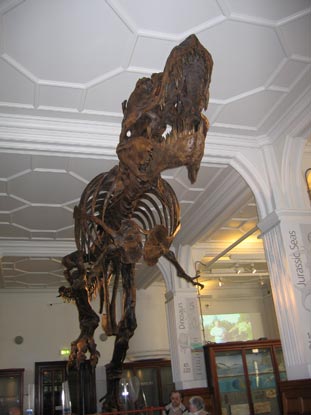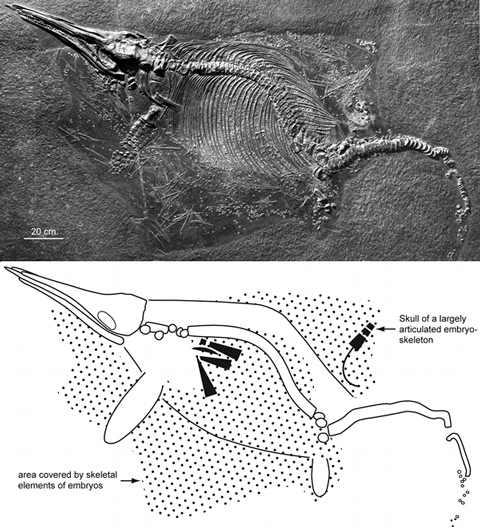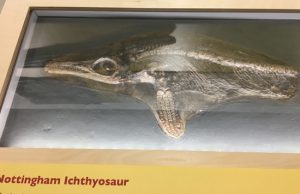Aquatic Dinosaur Theory Rises to the Surface Once Again
Cell Biologist Challenges Theory of Largely Terrestrial Dinosaurs
In a paper published in the scientific journal “Laboratory News” Professor Brian J. Ford has put forward a theory to help explain how these very heavy animals were able to move around – they lived in water. Using an assessment of the potential loadings on limbs in comparison with the largest land animals alive today; in combination with studies of dinosaur track-ways that show that their heavy tails were in most cases held off the ground, Professor Ford has concluded that as terrestrial animals – “Dinosaurs don’t work.”
Had this paper been published on Sunday April 1st – then Professor Ford’s hypothesis would have been in danger of being consigned to that taxonomic waste-basket where all April Fool’s get sent, but this is a legitimate and thought provoking piece that has even been discussed on the Radio 4 programme “Today”.
Professor Ford, a cell biologist writes:
“The immense size of the largest genera places impossible loadings on their extremities. A single limb would have to support many tonnes – this would not be compatible with the agility we associate with dinosaurs. We accept the remains of their footprints with demur, although for such gigantic creatures, the imprints that we observe in rocky strata make no sense. The prints are roughly as deep in the layers of Liassic mud as ours might have been, although the high mass of an adult dinosaur would cause it to sink up to its knees. The footprints seem to be those of an altogether lighter organism.”
Unless of course, these are the footprints made as huge creatures, waded across shallow lakes. If this were the case, Professor Ford argues, then this would explain why the heavy tails do not drag on the ground, they would have been supported by water and held out behind the animal.
Dinosaurs
For Everything Dinosaur team members this is a case of “deja vu”, many of our team members can remember the theories that were still postulated by some scientists forty years ago, that the largest of the dinosaurs, the long-necked sauropods lived an aquatic lifestyle, with their great weight supported by the water column.
Many scientists in the 19th century and indeed into the later part of the 20th century believed that the very largest dinosaurs, the herbivorous, sauropods were aquatic. Opening a child’s dinosaur book from the 1950s and 1960s would often reveal a scene of these huge leviathans happily munching water weeds in a shallow lake or swamp.
Over the last fifty years or so, new scientific methodologies and fossil discoveries has led to the idea that the largest dinosaurs such as the sauropods were suited to a life in water, being disregarded by most palaeontologists. Anatomical studies, assessments of limb strength and other research has led to the conclusion that the vast majority of large dinosaur genera were very probably terrestrial.
Scientists set about examining other aspects of Dinosauria anatomy, for example how did the sauropods, dinosaurs like Brachiosaurus and Apatosaurus support their long-necks.
Sauropod Dinosaurs
To read more about the debate over the posture of sauropods: Swan-neck Posture of Sauropods.
Professor Ford, goes further than the early 20th century scientists who confined their water-based dinosaur theories to the super-heavy-weights of the Sauropodomorpha. In the article published in Laboratory News, the professor discusses the suitability of Tyrannosaurus rex to a watery habitat.
When discussing the fore-shortened front limbs found in many Late Cretaceous theropods, professor Ford suggests:
“The diminished forelimbs are equally well accounted for… In land animals, like the elephant, hippo and rhinoceros, each of the four limbs is load-bearing and evolutionary pressure has been against the reduction in size that we observe in flesh-eating dinosaurs like Tyrannosaurus.”
Tyrannosaurus rex – A Predator of Lakes and Rivers?
Picture credit: Everything Dinosaur
So if you are bipedal and a predator, perhaps you might have been at home in a shallow lake where the weight of the water could help support your body mass and make it more energy efficient for you to move around.
Concerning T. rex professor Ford states:
“If the large dinosaurs are conceived as primarily aquatic, however, then the specialisation of the forelimbs would be towards manipulative dexterity. The fact that the limbs became foreshortened is entirely reasonable. Animals like to inspect their food as they eat, and holding it closer to the face is normal behaviour. Conventionally, conceived the small forelimbs of T. rex make no sense – however, if we envision the animal as an aquatic, carnivorous species, this adaptation becomes entirely reasonable.”
This is certainly an interesting point of view. Ironically, many of the facultative bipeds that shared the Late Cretaceous with the tyrannosaurs – the hadrosaurs (duck-billed dinosaurs), for example, were thought by some scientists in the 19th and 20th centuries to be aquatic. The bizarre looking hollow crests on some of these dinosaurs were thought to act as air reservoirs or snorkels, enabling these plant-eaters to run into deep water to escape the attentions of a predator such as Tyrannosaurus rex.
Old illustrations show two duck-billed dinosaurs (Corythosaurus and Parasaurolophus) swimming underwater to escape a predator. This picture is taken from a beautiful book about dinosaurs and other prehistoric animals first published in 1966, when the theory of some dinosaurs being aquatic was still propounded by a number of scientists and academics.
For models and replicas of sauropods, theropods and other dinosaurs: Dinosaur Models for Sale.
Interestingly, professor Ford does draw inspiration for this theory from recent studies of another theropod (meat-eating dinosaur) – Spinosaurus. Chemical analysis of spinosaurid teeth by Romain Amiot and colleagues at the University of Lyon revealed that spinosaurs may have spent a large part of their lives near or in water. Isotope analysis revealed a similar pattern as found in extant reptiles today that are aquatic – crocodiles and turtles.
To read an article suggesting a more aquatic life-style for Spinosaurids: Swimming Spinosaurs.
When asked to comment on the paper, a spokesperson from Everything Dinosaur stated:
“What goes around comes around, sometimes new evidence emerges that leads palaeontologists to question accepted scientific thinking. However, there is a significant amount of research that suggests that the Dinosauria, even the largest genera, were very well adapted to a life on land”.
Time will tell, perhaps new fossil finds and further developments in research techniques will reveal more conclusive evidence, in the meantime, we at Everything Dinosaur, whilst acknowledging the contribution of Professor Ford to this debate, still believe that dinosaurs were largely terrestrial animals.
You could say, that, for the moment at least, the aquatic dinosaurs theory does not hold water.




